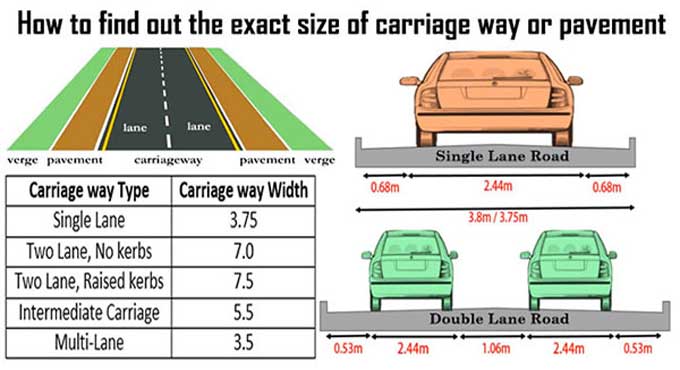
The Importance of Carriageway in Roads and the Types of Carriageways
Carriageways are composed of various components, including the road width, cross slope, asphalt, pavement margins, traffic separators, and curbs. Psychological factors, vehicle characteristics, and traffic patterns influence these geometric elements. A skillful management of these elements ensures highway safety.
Carriageway is an essential component of any road network. It refers to the part of the road where vehicles are meant to travel. It is the section of the road that is designed to accommodate vehicles, and it is one of the most critical parts of a road. There are several reasons why the carriageway is so important.
Define Carriageway
Carriageways are portions of roads that allow traffic to move freely. A pavement width has multiple traffic lanes. Traffic lanes are those portions of carriageway that allow one-line traffic movement. There is a median strip that separates the various lanes on the carriageway. Carriageways are classified based on their purpose, needs, and locations.
Importance of Carriageway
Smooth and Safe
Firstly, the carriageway is responsible for providing a smooth and safe surface for vehicles to travel on. A well-maintained carriageway can reduce the likelihood of accidents, as it reduces the risk of skidding, sliding, or hydroplaning. This, in turn, can improve the overall safety of the road network.
Predictable and Consistent
Secondly, the carriageway is responsible for providing a predictable and consistent surface for vehicles to travel on. This is important for drivers, as it allows them to anticipate any changes in the road surface, such as potholes or bumps. A consistent surface also helps to reduce driver fatigue, which can be a major factor in accidents.
Clear and Visible Path
Thirdly, the carriageway is responsible for providing a clear and visible path for vehicles to travel on. This is important for drivers, as it allows them to see where they are going and make any necessary adjustments. A clear and visible path also helps to reduce driver confusion, which can be a major factor in accidents.
Durable and long lasting
Finally, the carriageway is responsible for providing a durable and long lasting surface for vehicles to travel on. A well-maintained carriageway can last for many years, providing a reliable and consistent surface for vehicles to travel on. This is important for both drivers and road authorities, as it can help to reduce the costs associated with road maintenance and repair.
Carriageway Width
- In addition to the width of the traffic lane, the carriageway's width is dependent on the number of lanes that are provided along it. A standard vehicle such as a passenger car determines the width of the traffic lane.
- In addition, it is important to determine the maximum width of the widest vehicle class which is legally allowed to use the road system of that country, such as a heavy commercial vehicle.
- Neither side of the vehicles has insufficient lateral clearance due to the width of the lane. In cases of high speed vehicle movement, the lateral clearance is higher.
- Thus, considering all factors, rural highways in India usually have a width of 3.5 meters per lane, and highways in the United States and other countries have a width of 10 to 11 meters.
- The road is provided with raised kerbs as a footpath, and then lane width is increased to 3.75 meters. In India, the carriage width for single lane roads is 3.75m, though it is subject to decrease on low volume or village roads.
- There is a predicted traffic volume and a desired level of service that determine the number and type of traffic lanes required on a highway.
- On either side of the vehicle, the side clearance is 625 mm for a single vehicle with a maximum width of 2.5m. This yields a 3.75m carriageway width for single lane traffic with these parameters considered.
- Two lane roadways have a side clearance of 500mm on both sides, and 1000mm between two vehicles. When all these parameters are combined, the desired carriageway width for two lanes is 7m and for single lanes it is 3.5m.
Construction Process of Carriageway Width in India
In plains and rolling terrains, Expressways have a lane width of 3.75 meters, while in mountainous terrain, it is 3.5 meters; changing from 3.5 meters to 3.75 meters or 3.75 meters to 3.5 meters should be done smoothly at a rate of 1 in 60 meters for faster speeds.
It is possible to have a 3.5 meters lane width on urban roads without raised kerbs. A stalled vehicle should be accommodated by a minimum width of 5.5 meters on kerbed urban roads. Residential areas can reduce lane widths to three meters.
Carriageway Types
Single Carriageway
One lane roads are characterized by only one or two traffic lanes without a median strip that separates oppositely flowing traffic.
Dual Carriageway
There are two or more lanes on a dual carriageway, separated by a median strip, allowing two way traffic which means traffic travels in opposite directions.
To get more details, watch the following video tutorial.
Video Source: Theory Test Practice
Wrapping it Up
In conclusion, the carriageway is an essential component of any road network. It is responsible for providing a smooth, safe, predictable, clear, and durable surface for vehicles to travel on. Without a well maintained carriageway, the safety and efficiency of the road network can be compromised, leading to accidents, driver fatigue, confusion, and increased maintenance costs.


